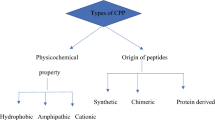Abstract
Cell-penetrating peptides can carry a variety of biologically active molecules into cells. Here we have identified a novel CPP derived from the C-terminus of human extracellular superoxide dismutase (hC-SOD3) which was shown to be located throughout in the cytoplasm and nucleus by fluorescence microscopy investigation. Furthermore, when apoptin fused to hC-SOD3, it was translocated efficiently into HeLa cells resulting in antitumor activities. This study shows that hC-SOD3 has the potential to penetrate and translocate cargo molecules into cells and has no cytotoxicity at effective concentration.







Similar content being viewed by others
References
Snyder EL, Dowdy SF (2004) Cell penetrating peptides in drug delivery. Pharm Res 21:389–393
Patel LN, Zaro JL, Shen WC (2007) Cell penetrating peptides: intracellular pathways and pharmaceutical perspectives. Pharm Res 24:1977–1992
Vivès E, Schmidt J, Pèlegrin A (2008) Cell-penetrating and cell-targeting peptides in drug delivery. Biochim Biophys Acta 1786:126–138
Ho A, Schwarze SR, Mermelstein SJ, Waksman G (2001) Dowdy SF synthetic protein transduction domains: enhanced transduction potential in vitro and in vivo. Cancer Res 61:474–477
Gao B, Flores SC, Leff JA, Bose SK, McCord JM (2003) Synthesis and anti-inflammatory activity of a chimeric recombinant superoxide dismutase: SOD2/3. Am J Physiol Lung Cell Mol Physiol 284:L917–L925
Ookawara T, Kizaki T, Takayama E, Imazeki N, Matsubara O et al (2002) Nuclear translocation of extracellular superoxide dismutase. Biochem Biophys Res Commun 296:54–61
Ookawara T, Eguchi H, Nishimura M, Kizaki T, Eiji T, Saitoh D et al (2003) Effects of oxidative stress on the nuclear translocation of extracellular superoxide dismutase. Biochem Biophys Res Commun 303:914–919
Chu Y, Piper R, Richardson S, Watanabe Y, Patel P (2006) Heistad DD endocytosis of extracellular superoxide dismutase into endothelial cells: role of the heparin- binding domain. Arterioscler Thromb Vasc Biol 26:1985–1990
Tibell LA, Sethson I, Buevich AV (1997) Characterization of the heparin-binding domain of human extracellular superoxide dismutase. Biochim Biophys Acta 1340:21–32
Niidome T, Ohmori N, Ichinose A, Wada A, Mihara H, Hirayama T (1997) Aoyagi H binding of cationic a-helical peptides to plasmid DNA and their gene transfer abilities into cells. J Biol Chem 272:15307–15312
Hakansson S, Jacobs A, Caffrey M (2001) Hepain binding by the HIV-1 tat protein transduction domain. Protein Sci 10:2138–2139
Noteborn MH, Verschueren CA, Koch G, Van der Eb AJ (1998) Simultaneous expression of recombinant baculovirus-encoded chicken anaemia virus (CAV) proteins VP1 and VP2 is required for formation of the CAV-specific neutralizing epitope. J Gen Virol 79:3073–3077
Noteborn MH (2008) Apoptin:therapeutic potential of an early sensor of carcinogenic transformation. Annu Rev Pharmacol Toxicol 48:143–169
Sambrook DJ, Holt PJ, Lowe CR et al (1989) Molecular cloning:a laboratory manual. Cold Spring Harbor Laboratory, New York
Bradford MM (1976) A rapid and sensitive method for the quantization of microgram quantities of protein utilizing the principle of protein-dye binding. Anal Biochem 72:248–254
Guelen L, Paterson H, Ga¨ken J et al (2004) TAT-apoptin is efficiently delivered and induces apoptosis in cancer cells. Oncogene 23:1153–1165
Sandstrom J, Nilsson P, Karlsson K, Marklund SL (1994) Tenfold increase in human plasma extracellular superoxide dismutase content caused by a mutation in heparin-binding domain. J. Biol.Chem 269:19163–19166
Petersen SV, Olsen DA, Kenney JM, Oury TD, Valnickova Z, Thogersen IB, Crapo JD, Enghild JJ (2005) The high concentration of Arg213→Gly extracellular superoxide dismutase (EC-SOD) in plasma is caused by a reduction of both heparin and collagen affinities. Biochem J 385:427–432
Petersen SV, Valnickova Z, Oury TD, Crapo JD, Chr Nielsen N, Enghild JJ (2007) The subunit composition of human extracellular superoxide dismutase (EC-SOD) regulate enzymatic activity. BMC Biochemistry 8:19
Qin Z, Reszka KJ, Fukai T, Weintraub NL (2008) Extracellular superoxide dismutase (ecSOD) in vascular biology: an update on exogenous gene transfer and endogenous regulators of ecSOD. Transl Res 151(2):68–78
Author information
Authors and Affiliations
Corresponding author
Rights and permissions
About this article
Cite this article
Zhao, J., Gao, P., Xiao, W. et al. A novel human derived cell-penetrating peptide in drug delivery. Mol Biol Rep 38, 2649–2656 (2011). https://doi.org/10.1007/s11033-010-0406-6
Received:
Accepted:
Published:
Issue Date:
DOI: https://doi.org/10.1007/s11033-010-0406-6




